Retrieval of Cloud, Atmospheric, and Surface Properties from Far-Infrared Spectral Radiances Measured by FIRMOS-B During the 2022 HEMERA Stratospheric Balloon Campaign
Abstract
1. Introduction
2. FIRMOS-B HEMERA Balloon Campaign
3. Retrieval Methods
4. Retrieval Results in Cloudy Conditions
4.1. Spectral Fitting Results
4.2. Retrieval of Atmospheric Profiles of Water Vapour and Temperature in the Presence of Clouds
4.3. Simultaneous Retrieval of Cloud Parameters
5. Retrieval of Surface Emissivity in Clear-Sky Conditions
6. Conclusions
Author Contributions
Funding
Data Availability Statement
Acknowledgments
Conflicts of Interest
Appendix A. Conversion from Ice/Water Mass Mixing Ratio to Integrated Ice/Water Path (IWP/LWP)
References
- Kumar, B.; Ranjan, R.; Yau, M.K.; Bera, S.; Rao, S.A. Impact of high- and low-vorticity turbulence on cloud–environment mixing and cloud microphysics processes. Atmos. Chem. Phys. 2021, 21, 12317–12329. [Google Scholar] [CrossRef]
- Hartmann, D.L.; Ockert-Bell, M.E.; Michelsen, M.L. The Effect of Cloud Type on Earth’s Energy Balance: Global Analysis. J. Clim. 1992, 5, 1281–1304. [Google Scholar] [CrossRef]
- Baran, A.J. A review of the light scattering properties of cirrus. J.Quant. Spectrosc. Radit. Transf. 2009, 110, 1239–1260. [Google Scholar] [CrossRef]
- Matus, A.V.; L’Ecuyer, T.S. The role of cloud phase in Earth’s radiation budget. J. Geophys. Res. Atmos. 2017, 122, 2559–2578. [Google Scholar] [CrossRef]
- Boucher, O.; Randall, D.; Artaxo, P.; Bretherton, C.; Feingold, G.; Forster, P.; Kerminen, V.M.; Kondo, Y.; Liao, H.; Lohmann, U.; et al. 2013: Clouds and Aerosols. In Climate Change 2013: The Physical Science Basis; Contribution of Working Group I to the Fifth Assessment Report of the Intergovernmental Panel on Climate Change; Cambridge University Press: Cambridge, UK, 2013. [Google Scholar]
- Cox, C.V.; Harries, J.E.; Taylor, J.P.; Green, P.D.; Baran, A.J.; Pickering, J.C.; Last, A.E.; Murray, J.E. Measurement and simulation of mid-and far-infrared spectra in the presence of cirrus. Q. J. R. Meteorol. Soc. 2010, 136, 718–739. [Google Scholar] [CrossRef]
- Lubin, D.; Chen, B.; Bromwitch, D.H.; Somerville, R.C.J.; Lee, W.H.; Hines, K.M. The Impact of Antarctic Cloud Radiative Properties on a GCM Climate Simulation. J. Clim. 1998, 11, 447–462. [Google Scholar] [CrossRef]
- Lawson, R.P.; Baker, B.A.; Zmarzly, P.; O’Connor, D.; Mo, Q.; Gayet, J.F.; Shcherbakov, V. Microphysical and Optical Properties of Atmospheric Ice Crystals at South Pole Station. J. Appl. Meteorol. Climatol. 2006, 45, 1505–1524. [Google Scholar] [CrossRef]
- Yang, P.; Bi, L.; Baum, B.A.; Liou, K.N.; Kattawar, G.W.; Mishchenko, M.I.; Cole, B. Spectrally Consistent Scattering, Absorption, and Polarization Properties of Atmospheric Ice Crystals at Wavelengths from 0.2 to 100 μm. J. Atmos. Sci. 2013, 70, 330–347. [Google Scholar] [CrossRef]
- Bi, L.; Yang, P. Improved ice particle optical property simulations in the ultraviolet to far-infrared regime. J. Quant. Spectrosc. Radiat. Transf. 2017, 189, 228–237. [Google Scholar] [CrossRef]
- Intrieri, J.M.; Fairall, C.W.; Shupe, M.D.; Persson, P.O.G.; Andreas, E.L.; Guest, P.S.; Moritz, R.E. An annual cycle of Arctic surface cloud forcing at SHEBA. J. Geophys. Res. Ocean. 2002, 107, SHE 13-1–SHE 13-14. [Google Scholar] [CrossRef]
- Stapf, J.; Ehrlich, A.; Jäkel, E.; Lüpkes, C.; Wendisch, M. Reassessment of shortwave surface cloud radiative forcing in the Arctic: Consideration of surface-albedo–cloud interactions. Atmos. Chem. Phys. 2020, 20, 9895–9914. [Google Scholar] [CrossRef]
- Clough, S.A.; Iacono, M.J.; Moncet, J.L. Line-by-line calculations of atmospheric fluxes and cooling rates: Application to water vapor. J. Geophys. Res. Atmos. 1992, 97, 15761–15785. [Google Scholar] [CrossRef]
- Harries, J.; Carli, B.; Rizzi, R.; Serio, C.; Mlynczak, M.; Palchetti, L.; Maestri, T.; Brindley, H.; Masiello, G. The Far Infrared Earth. Rev. Geophys. 2008, 46, 1–34. [Google Scholar] [CrossRef]
- Palchetti, L.; Natale, G.D.; Bianchini, G. Remote sensing of cirrus microphysical properties using spectral measurements over the full range of their thermal emission. J. Geophys. Res. 2016, 121, 10,804–10,819. [Google Scholar] [CrossRef]
- Di Natale, G.; Barucci, M.; Belotti, C.; Bianchini, G.; D’Amato, F.; Del Bianco, S.; Gai, M.; Montori, A.; Sussmann, R.; Viciani, S.; et al. Comparison of mid-latitude single- and mixed-phase cloud optical depth from co-located infrared spectrometer and backscatter lidar measurements. Atmos. Meas. Tech. 2021, 14, 6749–6758. [Google Scholar] [CrossRef]
- Knuteson, R.O.; Revercomb, H.E.; Best, F.A.; Ciganovich, N.C.; Dedecker, R.G.; Dirkx, T.P.; Ellington, S.C.; Feltz, W.F.; Garcia, R.K.; Howell, H.B.; et al. Atmospheric Emitted Radiance Interferometer. Part I: Instrument Design. J. Atmos. Ocean. Technol. 2004, 21, 1763–1776. [Google Scholar] [CrossRef]
- Garrett, T.J.; Zhao, C. Ground-based remote sensing of thin clouds in the Arctic. Atmos. Meas. Tech. 2013, 6, 1227–1243. [Google Scholar] [CrossRef]
- Turner, D.D. Microphysical Properties of Single and Mixed-Phase Arctic Clouds Derived from Ground-Based AERI Observations. Ph.D. Thesis, University of Wisconsin–Madison, Madison, WI, USA, 2003. Volume 35. pp. 1–167. [Google Scholar]
- Shupe, M.D.; Turner, D.D.; Walden, V.P.; Bennartz, R.; Cadeddu, M.P.; Castellani, B.B.; Cox, C.J.; Hudak, D.R.; Kulie, M.S.; Miller, N.B.; et al. High and Dry: New Observations of Tropospheric and Cloud Properties above the Greenland Ice Sheet. Bull. Am. Meteorol. Soc. 2013, 94, 169–186. [Google Scholar] [CrossRef]
- Murray, J.E.; Warwick, L.; Brindley, H.; Last, A.; Quigley, P.; Rochester, A.; Dewar, A.; Cummins, D. The Far INfrarEd Spectrometer for Surface Emissivity (FINESSE). Part 1: Instrument description and level 1 radiances. Atmos. Meas. Tech. Discuss. 2024, 2024, 1–32. [Google Scholar] [CrossRef]
- Warwick, L.; Murray, J.; Brindley, H. The Far-INfrarEd Spectrometer for Surface Emissivity (FINESSE) Part II: First measurements of the emissivity of water in the far-infrared. Atmos. Meas. Tech. Discuss. 2024, 2024, 1–21. [Google Scholar] [CrossRef]
- Maesh, A.; Walden, V.P.; Warren, S.G. Ground-Based Infrared Remote Sensing of Cloud Properties over the Antarctic Plateau. Part I: Cloud-Base Heights. J. Appl. Meteorol. 2001, 40, 1265–1277. [Google Scholar] [CrossRef]
- Maesh, A.; Walden, V.P.; Warren, S.G. Ground-based remote sensing of cloud properties over the Antarctic Plateau: Part II: Cloud optical depth and particle sizes. J. Appl. Meteorol. 2001, 40, 1279–1294. [Google Scholar] [CrossRef]
- Bianchini, G.; Castagnoli, F.; Natale, G.D.; Palchetti, L. A Fourier transform spectroradiometer for ground-based remote sensing of the atmospheric downwelling long-wave radiance. Atmos. Meas. Tech. 2019, 12, 619–635. [Google Scholar] [CrossRef]
- Palchetti, L.; Bianchini, G.; Natale, G.D.; Guasta, M.D. Far-Infrared radiative properties of water vapor and clouds in Antarctica. Bull. Am. Meteorol. Soc. 2015, 96, 1505–1518. [Google Scholar] [CrossRef]
- Di Natale, G.; Palchetti, L.; Bianchini, G.; Ridolfi, M. The two-stream δ-Eddington approximation to simulate the far infrared Earth spectrum for the simultaneous atmospheric and cloud retrieval. J. Quant. Spectrosc. Radiat. Transf. 2020, 246, 106927. [Google Scholar] [CrossRef]
- Di Natale, G.; Palchetti, L.; Bianchini, G.; Guasta, M.D. Simultaneous retrieval of water vapour, temperature and cirrus clouds properties from measurements of far infrared spectral radiance over the Antarctic Plateau. Atmos. Meas. Tech. 2017, 10, 825–837. [Google Scholar] [CrossRef]
- Bhawar, R.; Bianchini, G.; Bozzo, A.; Cacciani, M.; Calvello, M.R.; Carlotti, M.; Castagnoli, F.; Cuomo, V.; Di Girolamo, P.; Di Iorio, T.; et al. Spectrally resolved observations of atmospheric emitted radiance in the H2O rotation band. Geophys. Res. Lett. 2008, 35. [Google Scholar] [CrossRef]
- Serio, C.; Masiello, G.; Esposito, F.; Di Girolamo, P.; Di Iorio, T.; Palchetti, L.; Bianchini, G.; Muscari, G.; Pavese, G.; Rizzi, R.; et al. Retrieval of foreign-broadened water vapor continuum coefficients from emitted spectral radiance in the H2O rotational band from 240 to 590 cm−1. Opt. Express 2008, 16, 15816–15833. [Google Scholar] [CrossRef] [PubMed]
- Mlawer, E.J.; Turner, D.D.; Paine, S.N.; Palchetti, L.; Bianchini, G.; Payne, V.H.; Cady-Pereira, K.E.; Pernak, R.L.; Alvarado, M.J.; Gombos, D.; et al. Analysis of Water Vapor Absorption in the Far-Infrared and Submillimeter Regions Using Surface Radiometric Measurements From Extremely Dry Locations. J. Geophys. Res. Atmos. 2019, 124, 8134–8160. [Google Scholar] [CrossRef]
- Mlynczak, M.G.; Johnson, D.G.; Bingham, G.E.; Jucks, K.W.; Traub, W.A.; Gordley, L.; Yang, P. The far-infrared spectroscopy of the troposphere (FIRST) project. In Enabling Sensor and Platform Technologies for Spaceborne Remote Sensing; Komar, G.J., Wang, J., Kimura, T., Eds.; SPIE: Bellingham, WA, USA, 2006; Volume 5659, pp. 81–87. [Google Scholar] [CrossRef]
- Mast, J.C.; Mlynczak, M.G.; Cageao, R.P.; Kratz, D.P.; Latvakoski, H.; Johnson, D.G.; Turner, D.D.; Mlawer, E.J. Measurements of downwelling far-infrared radiance during the RHUBC-II campaign at Cerro Toco, Chile and comparisons with line-by-line radiative transfer calculations. J. Quant. Spectrosc. Radiat. Transf. 2017, 198, 25–39. [Google Scholar] [CrossRef]
- Mlynczak, M.G.; Cageao, R.P.; Mast, J.C.; Kratz, D.P.; Latvakoski, H.; Johnson, D.G. Observations of downwelling far-infrared emission at Table Mountain California made by the FIRST instrument. J. Quant. Spectrosc. Radiat. Transf. 2016, 170, 90–105. [Google Scholar] [CrossRef]
- Belotti, C.; Barbara, F.; Barucci, M.; Bianchini, G.; D’Amato, F.; Del Bianco, S.; Di Natale, G.; Gai, M.; Montori, A.; Pratesi, F.; et al. The Far-Infrared Radiation Mobile Observation System (FIRMOS) for spectral characterization of the atmospheric emission. Atmos. Meas. Tech. 2023, 16, 2511–2529. [Google Scholar] [CrossRef]
- Turner, D.D.; Mlawer, E.J.; Bianchini, G.; Cadeddu, M.P.; Crewell, S.; Delamere, J.S.; Knuteson, R.O.; Maschwitz, G.; Mlynczak, M.; Paine, S.; et al. Ground-based high spectral resolution observations of the entire terrestrial spectrum under extremely dry conditions. Geophys. Res. Lett. 2012, 39. [Google Scholar] [CrossRef]
- Palchetti, L.; Barucci, M.; Belotti, C.; Bianchini, G.; Cluzet, B.; D’Amato, F.; Del Bianco, S.; Di Natale, G.; Gai, M.; Khordakova, D.; et al. Observations of the downwelling far-infrared atmospheric emission at the Zugspitze observatory. Earth Syst. Sci. Data 2021, 13, 4303–4312. [Google Scholar] [CrossRef]
- Canas, T.A.; Murray, J.E.; Harries, J.E. Tropospheric airborne Fourier transform spectrometer (TAFTS). In Satellite Remote Sensing of Clouds and the Atmosphere II; Haigh, J.D., Ed.; International Society for Optics and Photonics, SPIE: Bellingham, WA, USA, 1997; Volume 3220, pp. 91–102. [Google Scholar] [CrossRef]
- Cox, C.V.; Murray, J.E.; Taylor, J.P.; Green, P.D.; Pickering, J.C.; Harries, J.E.; Last, A.E. Clear-sky far-infrared measurements observed with TAFTS during the EAQUATE campaign, September 2004. Q. J. R. Meteorol. Soc. 2007, 133, 273–283. [Google Scholar] [CrossRef]
- Bantges, R.J.; Brindley, H.E.; Murray, J.E.; Last, A.E.; Russell, J.E.; Fox, C.; Fox, S.; Harlow, C.; O’Shea, S.J.; Bower, K.N.; et al. A test of the ability of current bulk optical models to represent the radiative properties of cirrus cloud across the mid- and far-infrared. Atmos. Chem. Phys. 2020, 20, 12889–12903. [Google Scholar] [CrossRef]
- Bellisario, C.; Brindley, H.E.; Murray, J.E.; Last, A.; Pickering, J.; Harlow, R.C.; Fox, S.; Fox, C.; Newman, S.M.; Smith, M.; et al. Retrievals of the Far Infrared Surface Emissivity Over the Greenland Plateau Using the Tropospheric Airborne Fourier Transform Spectrometer (TAFTS). J. Geophys. Res. Atmos. 2017, 122, 12,152–12,166. [Google Scholar] [CrossRef]
- Warwick, L.; Brindley, H.; Roma, A.; Fox, S.; Havemann, S.; Murray, J.; Oetjen, H.; Price, H.; Schuettemeyer, D.; Sgheri, L.; et al. Retrieval of Tropospheric Water Vapor From Airborne Far-Infrared Measurements: A Case Study. J. Geophys. Res. Atmos. 2022, 127, e2020JD034229. [Google Scholar] [CrossRef]
- Panditharatne, S.; Brindley, H.; Cox, C.; Song, R.; Siddans, R.; Bantges, R.; Murray, J.; Fox, S.; Fox, C. Exploiting airborne far-infrared measurements to optimise an ice cloud retrieval. EGUsphere 2025, 2025, 1–28. [Google Scholar] [CrossRef]
- Wilson, S.H.S.; Atkinson, N.C.; Smith, J.A. The Development of an Airborne Infrared Interferometer for Meteorological Sounding Studies. J. Atmos. Ocean. Technol. 1999, 16, 1912–1927. [Google Scholar] [CrossRef]
- Palchetti, L.; Belotti, C.; Bianchini, G.; Castagnoli, F.; Carli, B.; Cortesi, U.; Pellegrini, M.; Camy-Peyret, C.; Jeseck, P.; Té, Y. Technical note: First spectral measurement of the Earth’s upwelling emission using an uncooled wideband Fourier transform spectrometer. Atmos. Chem. Phys. 2006, 6, 5025–5030. [Google Scholar] [CrossRef]
- Mlynczak, M.G.; Johnson, D.G.; Latvakoski, H.; Jucks, K.; Watson, M.; Kratz, D.P.; Bingham, G.; Traub, W.A.; Wellard, S.J.; Hyde, C.R.; et al. First light from the Far-Infrared Spectroscopy of the Troposphere (FIRST) instrument. Geophys. Res. Lett. 2006, 33. [Google Scholar] [CrossRef]
- Loeb, N.G.; Mayer, M.; Kato, S.; Fasullo, J.T.; Zuo, H.; Senan, R.; Lyman, J.M.; Johnson, G.C.; Balmaseda, M. Evaluating Twenty-Year Trends in Earth’s Energy Flows From Observations and Reanalyses. J. Geophys. Res. Atmos. 2022, 127, e2022JD036686. [Google Scholar] [CrossRef]
- Kato, S.; Rose, F.G.; Rutan, D.A.; Thorsen, T.J.; Loeb, N.G.; Doelling, D.R.; Huang, X.; Smith, W.L.; Su, W.; Ham, S.H. Surface Irradiances of Edition 4.0 Clouds and the Earth’s Radiant Energy System (CERES) Energy Balanced and Filled (EBAF) Data Product. J. Clim. 2018, 31, 4501–4527. [Google Scholar] [CrossRef]
- Palchetti, L.; Brindley, H.; Bantges, R.; Buehler, S.A.; Camy-Peyret, C.; Carli, B.; Cortesi, U.; Del Bianco, S.; Di Natale, G.; Dinelli, B.M.; et al. FORUM: Unique far-infrared satellite observations to better understand how Earth radiates energy to space. Bull. Am. Meteorol. Soc. 2020, 101, E2030–E2046. [Google Scholar] [CrossRef]
- Palchetti, L.; Olivieri, M.; Pompei, C.; Labate, D.; Brindley, H.; Natale, G.D.; Bianchini, G. The Far Infrared FTS for the FORUM Mission. In Light, Energy and the Environment; Optical Society of America: Leipzig, Germany, 2016; p. FTu3C.1. [Google Scholar] [CrossRef]
- Sgheri, L.; Belotti, C.; Ben-Yami, M.; Bianchini, G.; Carnicero Dominguez, B.; Cortesi, U.; Cossich, W.; Del Bianco, S.; Di Natale, G.; Guardabrazo, T.; et al. The FORUM end-to-end simulator project: Architecture and results. Atmos. Meas. Tech. 2022, 15, 573–604. [Google Scholar] [CrossRef]
- Ridolfi, M.; Tirelli, C.; Ceccherini, S.; Belotti, C.; Cortesi, U.; Palchetti, L. Synergistic retrieval and complete data fusion methods applied to simulated FORUM and IASI-NG measurements. Atmos. Meas. Tech. 2022, 15, 6723–6737. [Google Scholar] [CrossRef]
- Dinelli, B.M.; Ridolfi, M.; Masiello, G.; Serio, C.; Venafra, S.; Maestri, T.; Del Bianco, S.; Raspollini, P.; Lorenzi, G.; Palchetti, L. A Fast Retrieval Model for the Inversion of Surface, Atmospheric and Cloud properties from Nadir FIR and TIR measurements. In Proceedings of the Living Planet Symposium, Bonn, Germany, 23–27 May 2022. [Google Scholar]
- Clough, S.A.; Shephard, M.W.; Mlawer, E.J.; Delamere, J.S.; Iacono, M.J.; Cady-Pereira, K.; Boukabara, S.; Brown, P.D. Atmospheric radiative transfer modeling: A summary of the AER codes. Short Commun. J. Quant. Spectrosc. Radiat. Transf. 2005, 91, 233–244. [Google Scholar] [CrossRef]
- Masiello, G.; Serio, C.; Maestri, T.; Martinazzo, M.; Masin, F.; Liuzzi, G.; Venafra, S. The new σ—IASI code for all sky radiative transfer calculations in the spectral range 10 to 2760 cm−1: σ—IASI/F2N. J. Quant. Spectrosc. Radiat. Transf. 2024, 312, 108814. [Google Scholar] [CrossRef]
- Chou, M.D.; Lee, K.T.; Tsay, S.C.; Fu, Q. Parameterization for Cloud Longwave Scattering for Use in Atmospheric Models. J. Clim. 1999, 12, 159–169. [Google Scholar] [CrossRef]
- Dinelli, B.M.; Del Bianco, S.; Castelli, E.; Di Roma, A.; Lorenzi, G.; Premuda, M.; Barbara, F.; Gai, M.; Raspollini, P.; Di Natale, G. GBB-Nadir and KLIMA: Two Full Physics Codes for the Computation of the Infrared Spectrum of the Planetary Radiation Escaping to Space. Remote Sens. 2023, 15, 2532. [Google Scholar] [CrossRef]
- Yang, P.; Liou, K.N.; Bi, L.; Liu, C.; Yi, B.; Baum, B.A. On the radiative properties of ice clouds: Light scattering, remote sensing, and radiation parameterization. Adv. Atmos. Sci. 2015, 32, 32–63. [Google Scholar] [CrossRef]
- King, M.D.; Platnick, S.; Yang, P.; Arnold, G.T.; Gray, M.A.; Riedi, J.C.; Ackerman, S.A.; Liou, K.N. Remote Sensing of Liquid Water and Ice Cloud Optical Thickness and Effective Radius in the Arctic: Application of Airborne Multispectral MAS Data. J. Atmos. Ocean. Technol. 2004, 21, 857–875. [Google Scholar] [CrossRef]
- Yang, P.; Wei, H.L.; Baum, B.A.; Huang, H.L.; Heymsfield, A.J.; Hu, Y.X.; Gao, B.C.; Turner, D.D. The spectral signature of mixed-phase clouds composed of non-spherical ice crystals and spherical liquid droplets in the terrestrial window region. J. Quant. Spectrosc. Radiat. Transfer 2003, 79–80, 1171–1188. [Google Scholar] [CrossRef]
- Yang, P.; Wei, H.; Huang, H.-L.; Baum, B.A.; Hu, Y.X.; Kattawar, G.W.; Mishchenko, M.I.; Fu, Q. Scattering and absorption property database for nonspherical ice particles in the near-through far-infrared spectral region. Appl. Opt. 2005, 44, 5512–5523. [Google Scholar] [CrossRef] [PubMed]
- Rodgers, C.D. Inverse Methods for Atmospheric Sounding: Theory and Practice; World Scientific Publishing: Singapore; Hackensack, NJ, USA; London, UK, 2000. [Google Scholar]
- Levenberg, K. A Method for the Solution of Certain Non-Linear Problems in Least Squares. Q. Appl. Math. 1944, 2, 164–168. [Google Scholar] [CrossRef]
- Remedios, J.J.; Leigh, R.J.; Waterfall, A.M.; Moore, D.P.; Sembhi, H.; Parkes, I.; Greenhough, J.; Chipperfield, M.P.; Hauglustaine, D. MIPAS reference atmospheres and comparisons to V4.61/V4.62 MIPAS level 2 geophysical data sets. Atmos. Chem. Phys. Discuss. 2007, 7, 9973–10017. [Google Scholar] [CrossRef]
- Ben-Yami, M.; Oetjen, H.; Brindley, H.; Cossich, W.; Lajas, D.; Maestri, T.; Magurno, D.; Raspollini, P.; Sgheri, L.; Warwick, L. Emissivity retrievals with FORUM’s end-to-end simulator: Challenges and recommendations. Atmos. Meas. Tech. 2022, 15, 1755–1777. [Google Scholar] [CrossRef]
- Huang, X.; Chen, X.; Zhou, D.K.; Liu, X. An Observationally Based Global Band-by-Band Surface Emissivity Dataset for Climate and Weather Simulations. J. Atmos. Sci. 2016, 73, 3541–3555. [Google Scholar] [CrossRef]
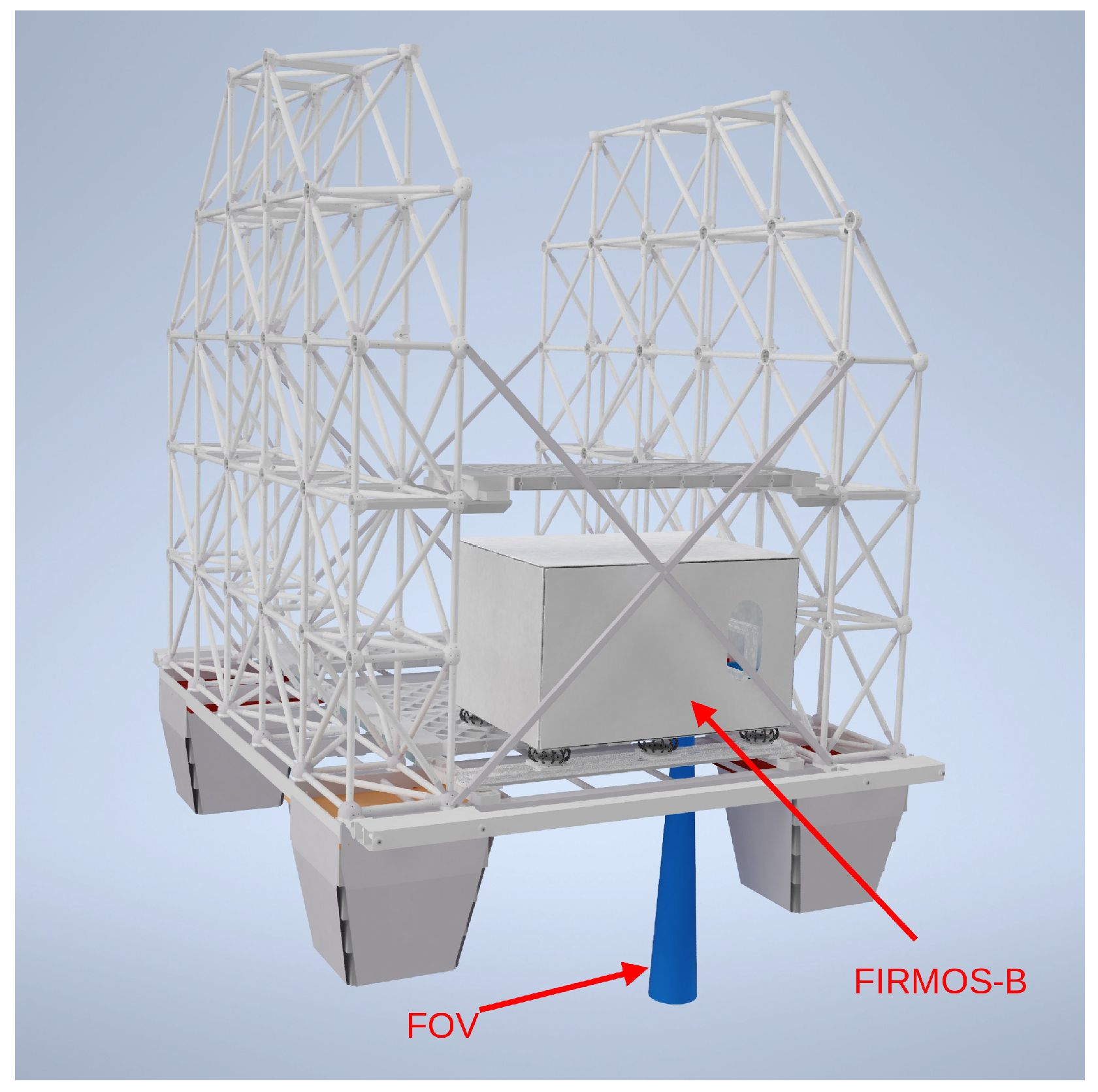

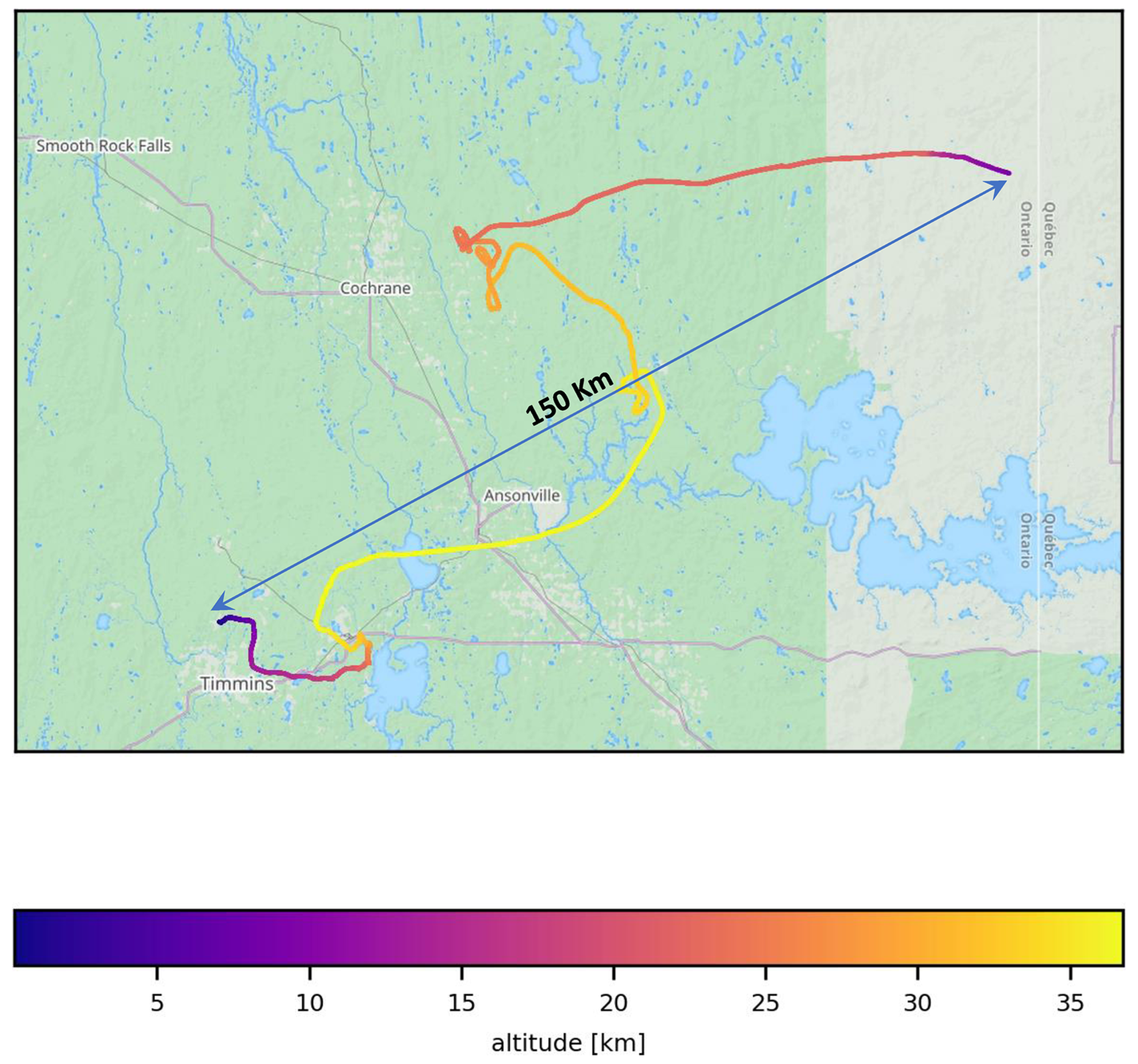

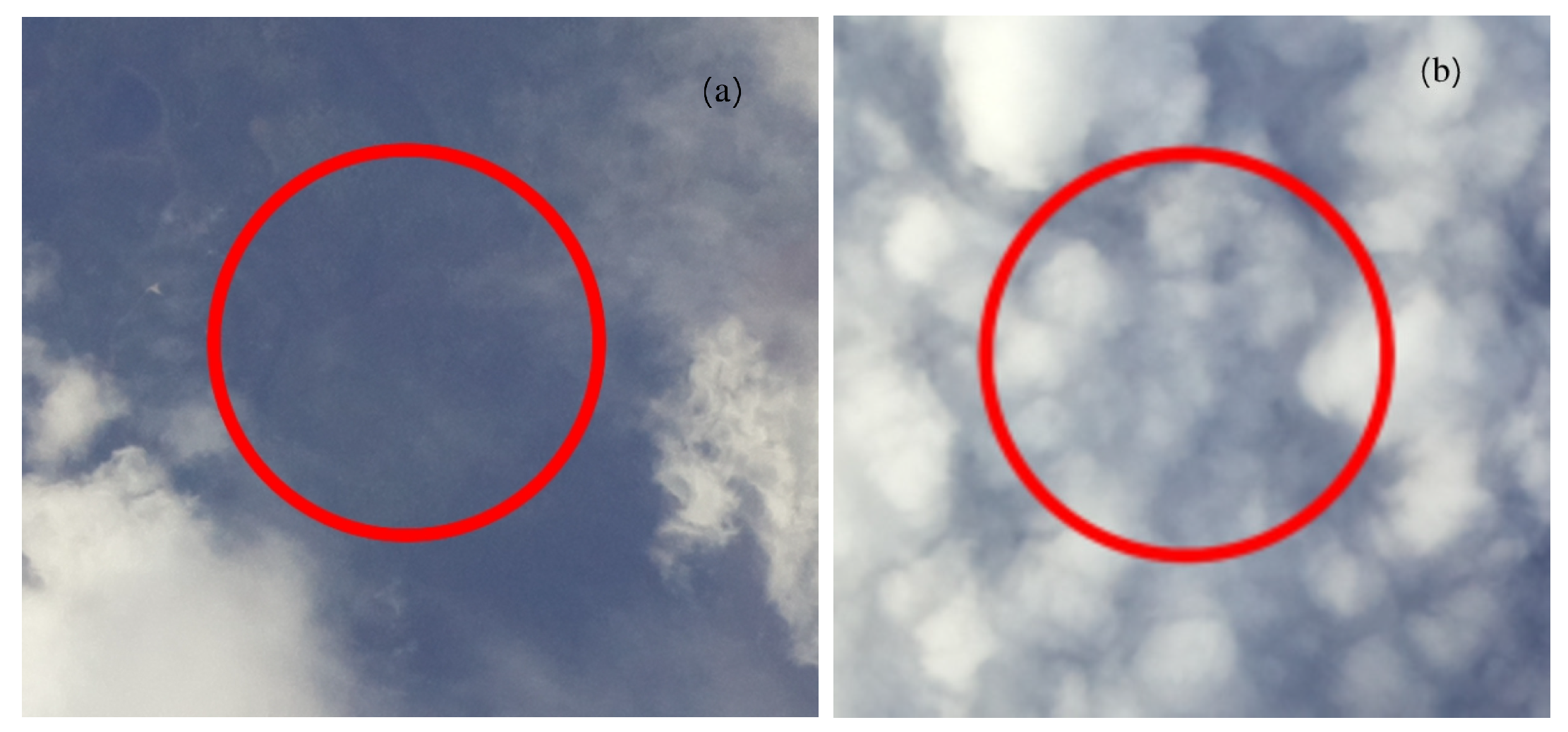
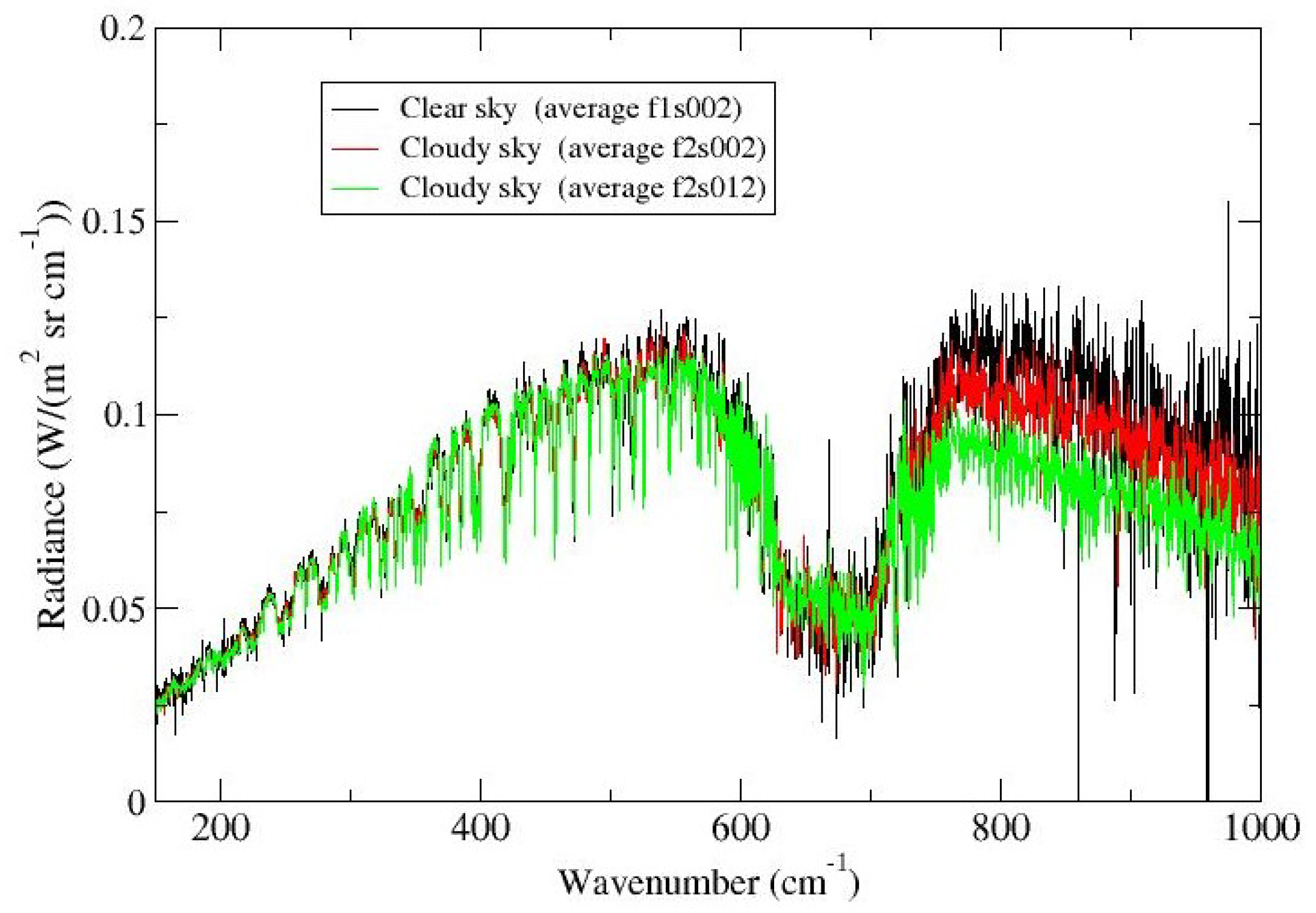
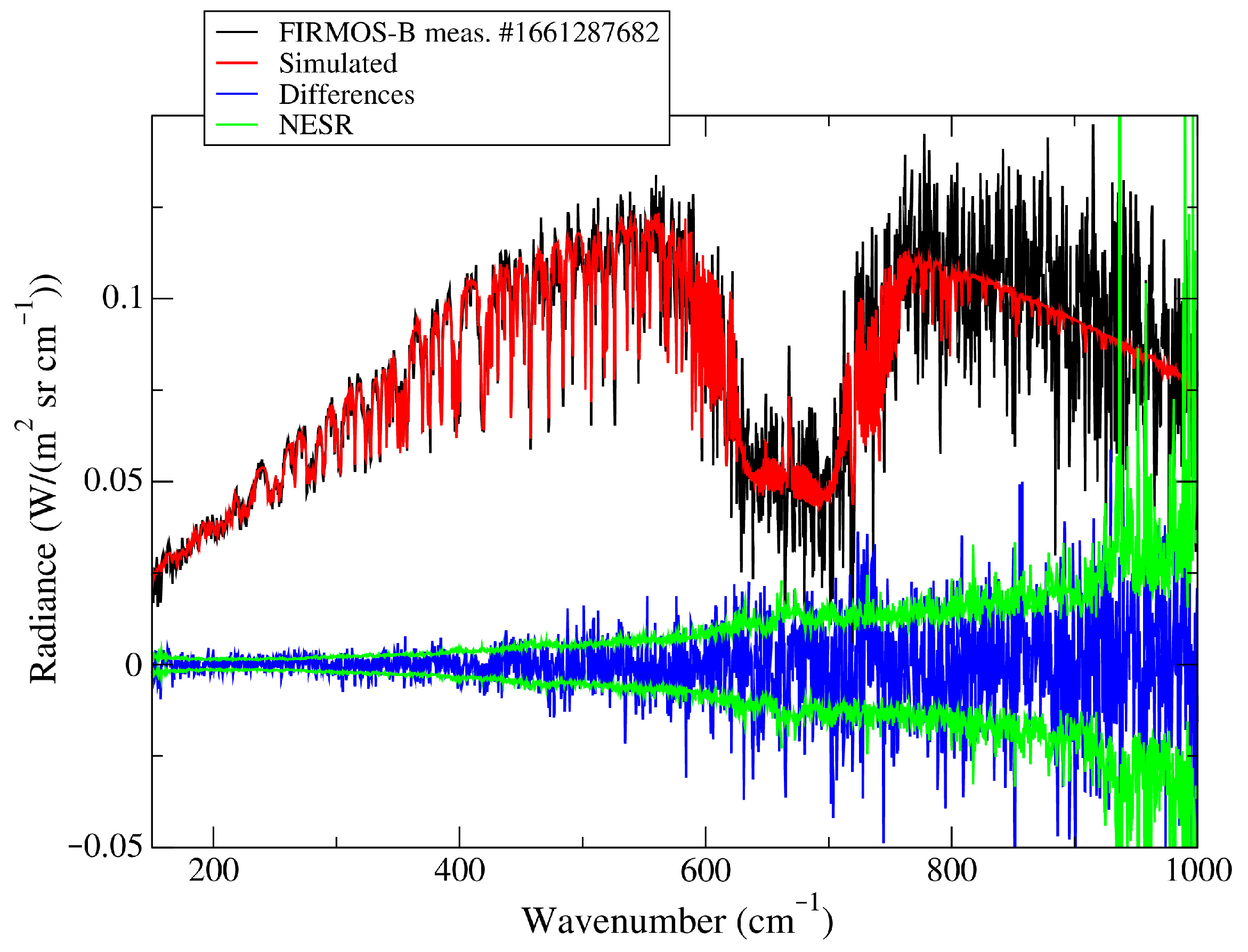
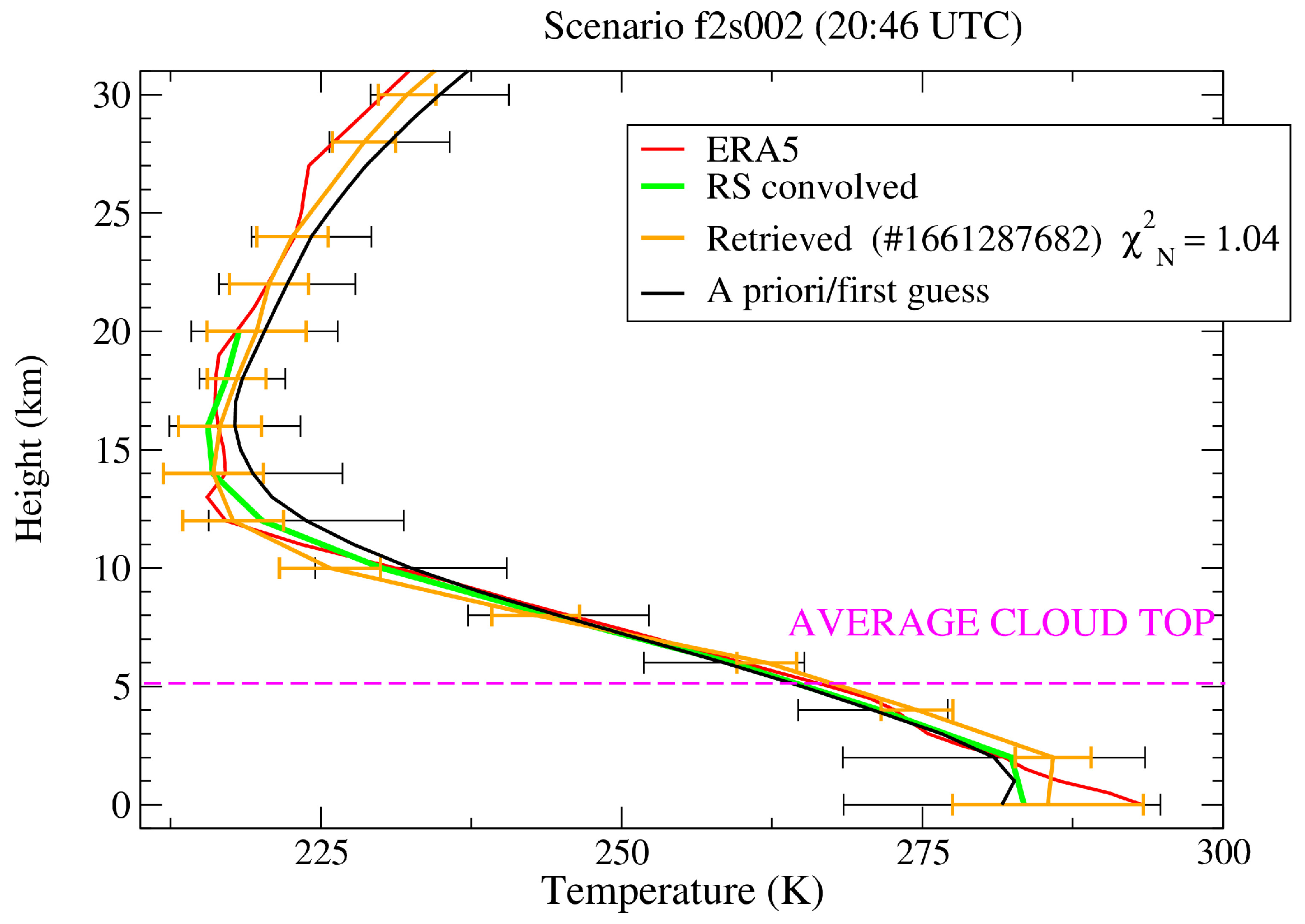
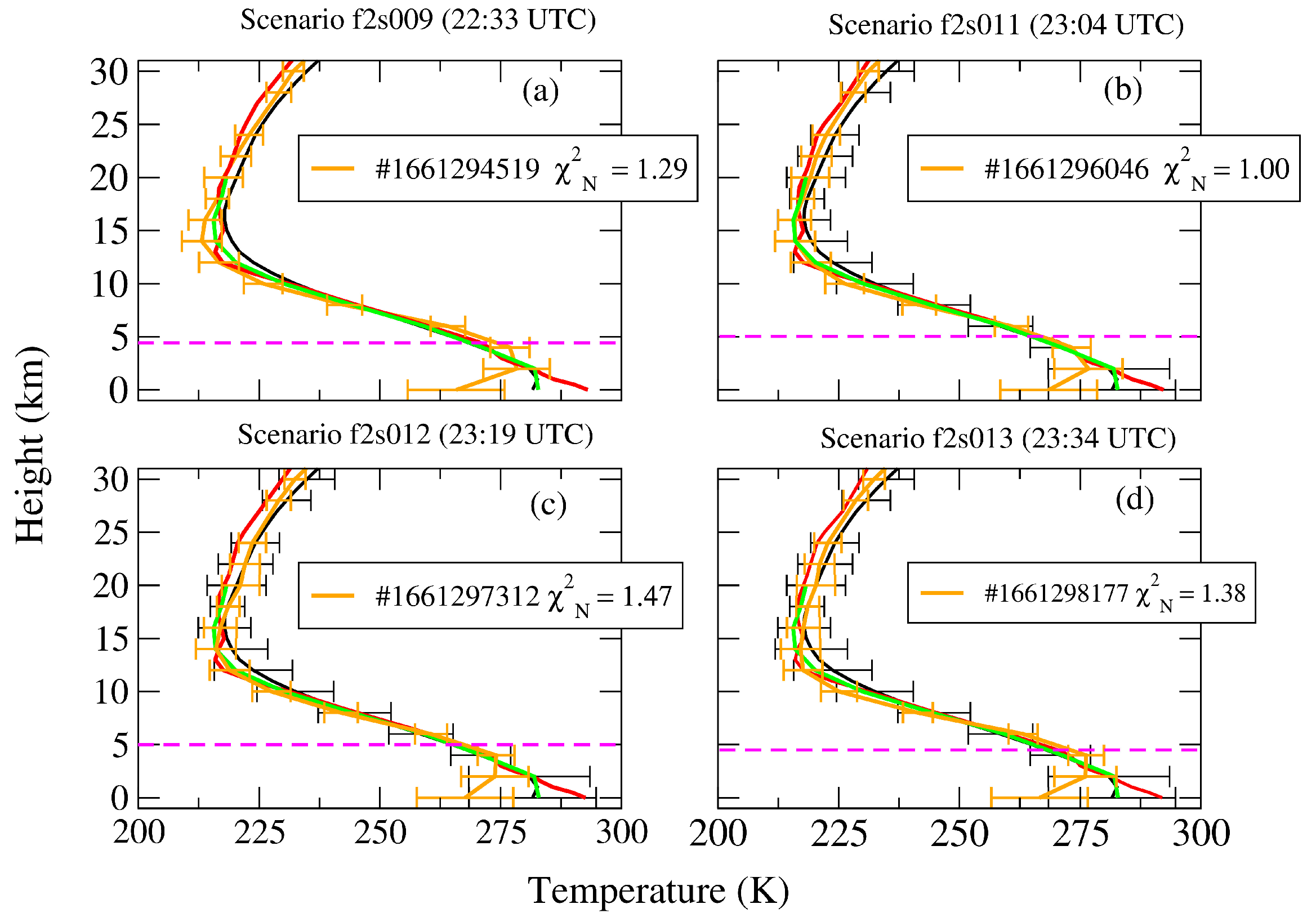
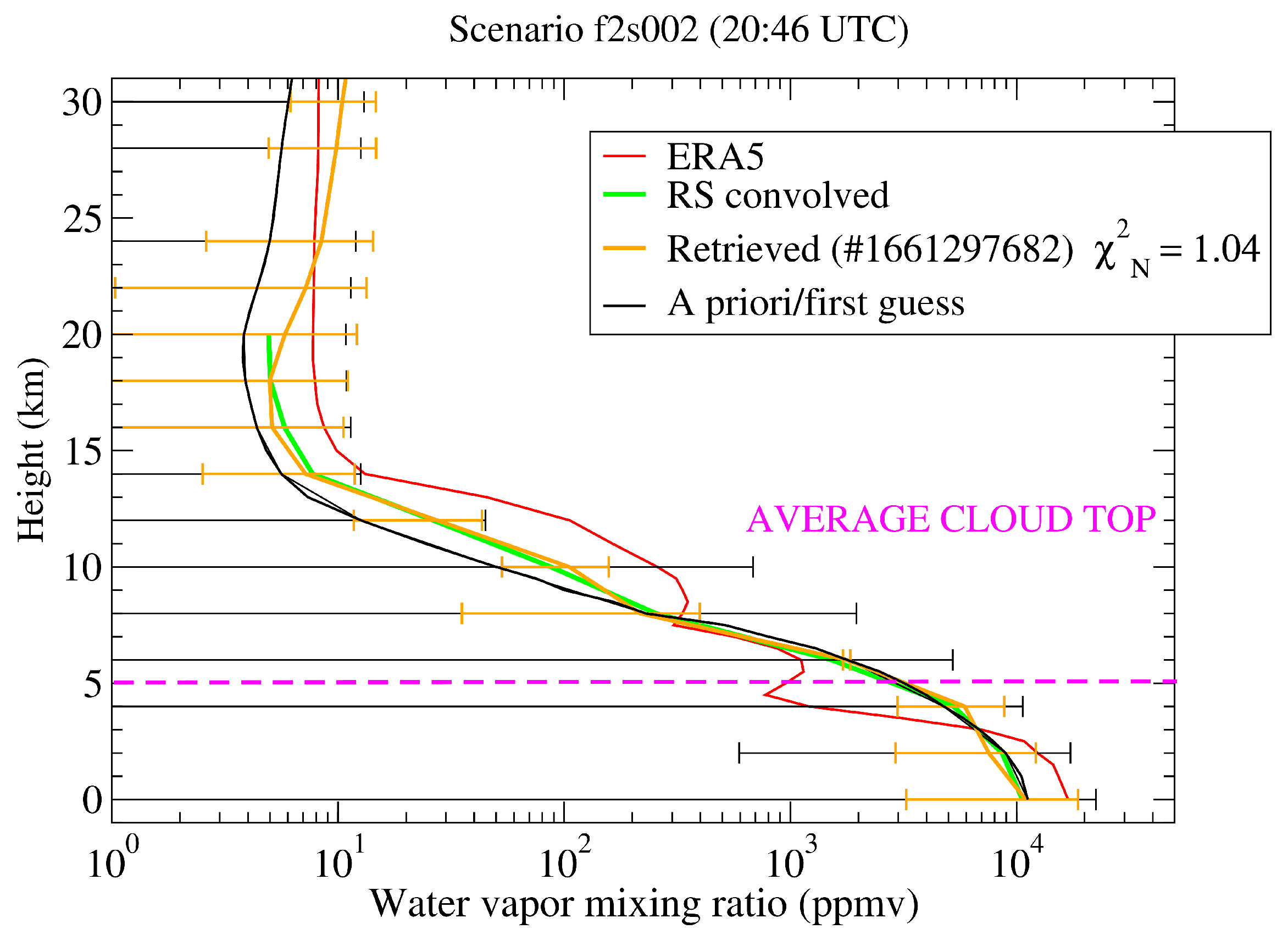
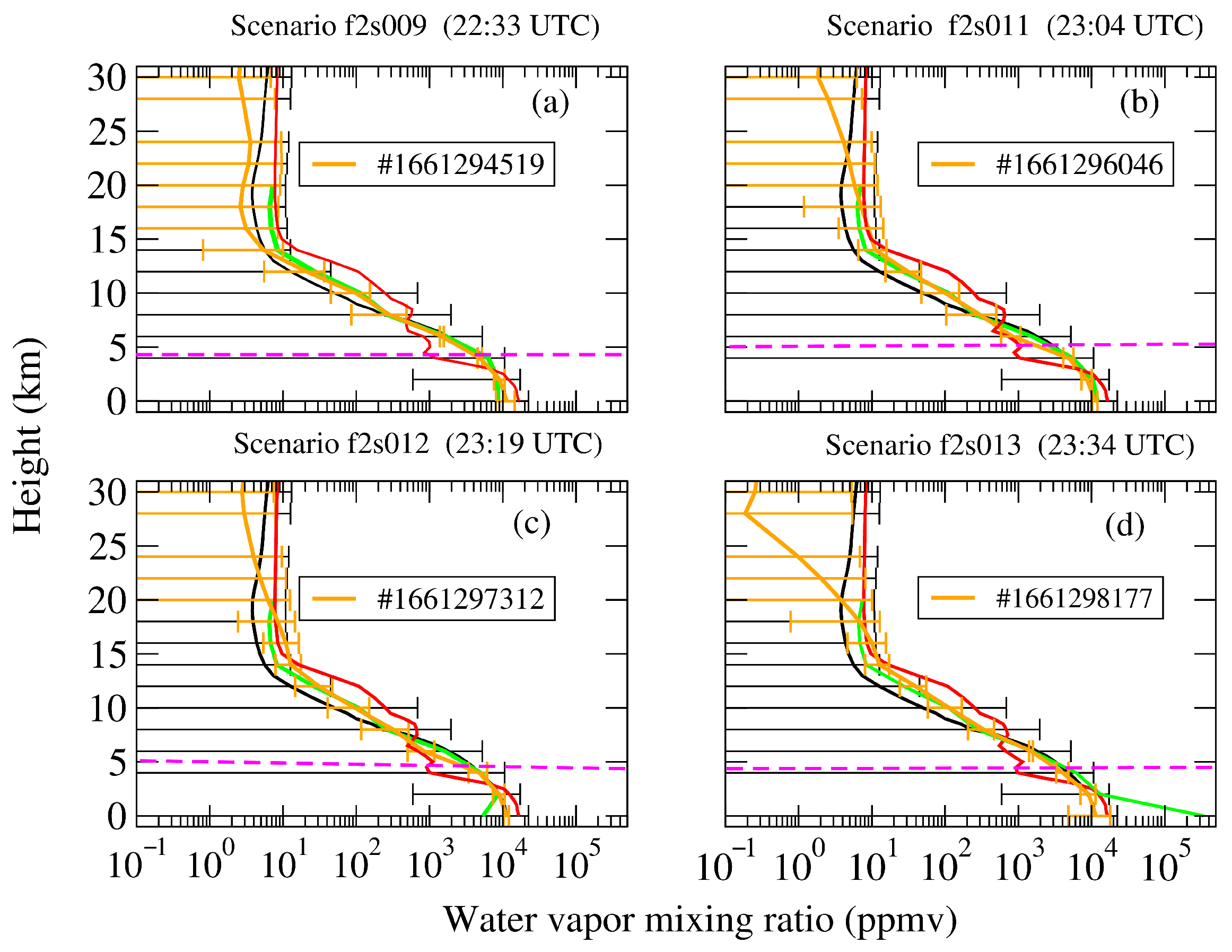


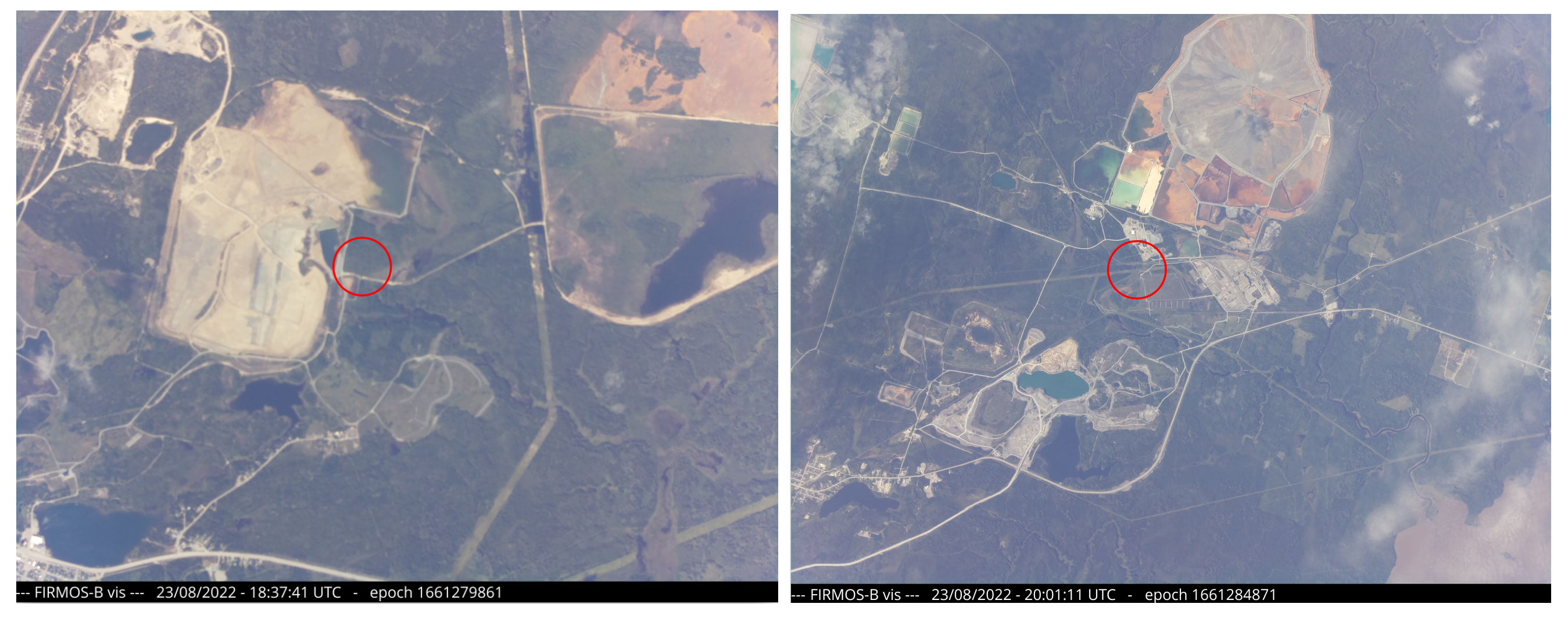

Disclaimer/Publisher’s Note: The statements, opinions and data contained in all publications are solely those of the individual author(s) and contributor(s) and not of MDPI and/or the editor(s). MDPI and/or the editor(s) disclaim responsibility for any injury to people or property resulting from any ideas, methods, instructions or products referred to in the content. |
© 2025 by the authors. Licensee MDPI, Basel, Switzerland. This article is an open access article distributed under the terms and conditions of the Creative Commons Attribution (CC BY) license (https://creativecommons.org/licenses/by/4.0/).
Share and Cite
Di Natale, G.; Belotti, C.; Barucci, M.; Ridolfi, M.; Viciani, S.; D’Amato, F.; Del Bianco, S.; Dinelli, B.M.; Palchetti, L. Retrieval of Cloud, Atmospheric, and Surface Properties from Far-Infrared Spectral Radiances Measured by FIRMOS-B During the 2022 HEMERA Stratospheric Balloon Campaign. Remote Sens. 2025, 17, 2458. https://doi.org/10.3390/rs17142458
Di Natale G, Belotti C, Barucci M, Ridolfi M, Viciani S, D’Amato F, Del Bianco S, Dinelli BM, Palchetti L. Retrieval of Cloud, Atmospheric, and Surface Properties from Far-Infrared Spectral Radiances Measured by FIRMOS-B During the 2022 HEMERA Stratospheric Balloon Campaign. Remote Sensing. 2025; 17(14):2458. https://doi.org/10.3390/rs17142458
Chicago/Turabian StyleDi Natale, Gianluca, Claudio Belotti, Marco Barucci, Marco Ridolfi, Silvia Viciani, Francesco D’Amato, Samuele Del Bianco, Bianca Maria Dinelli, and Luca Palchetti. 2025. "Retrieval of Cloud, Atmospheric, and Surface Properties from Far-Infrared Spectral Radiances Measured by FIRMOS-B During the 2022 HEMERA Stratospheric Balloon Campaign" Remote Sensing 17, no. 14: 2458. https://doi.org/10.3390/rs17142458
APA StyleDi Natale, G., Belotti, C., Barucci, M., Ridolfi, M., Viciani, S., D’Amato, F., Del Bianco, S., Dinelli, B. M., & Palchetti, L. (2025). Retrieval of Cloud, Atmospheric, and Surface Properties from Far-Infrared Spectral Radiances Measured by FIRMOS-B During the 2022 HEMERA Stratospheric Balloon Campaign. Remote Sensing, 17(14), 2458. https://doi.org/10.3390/rs17142458







